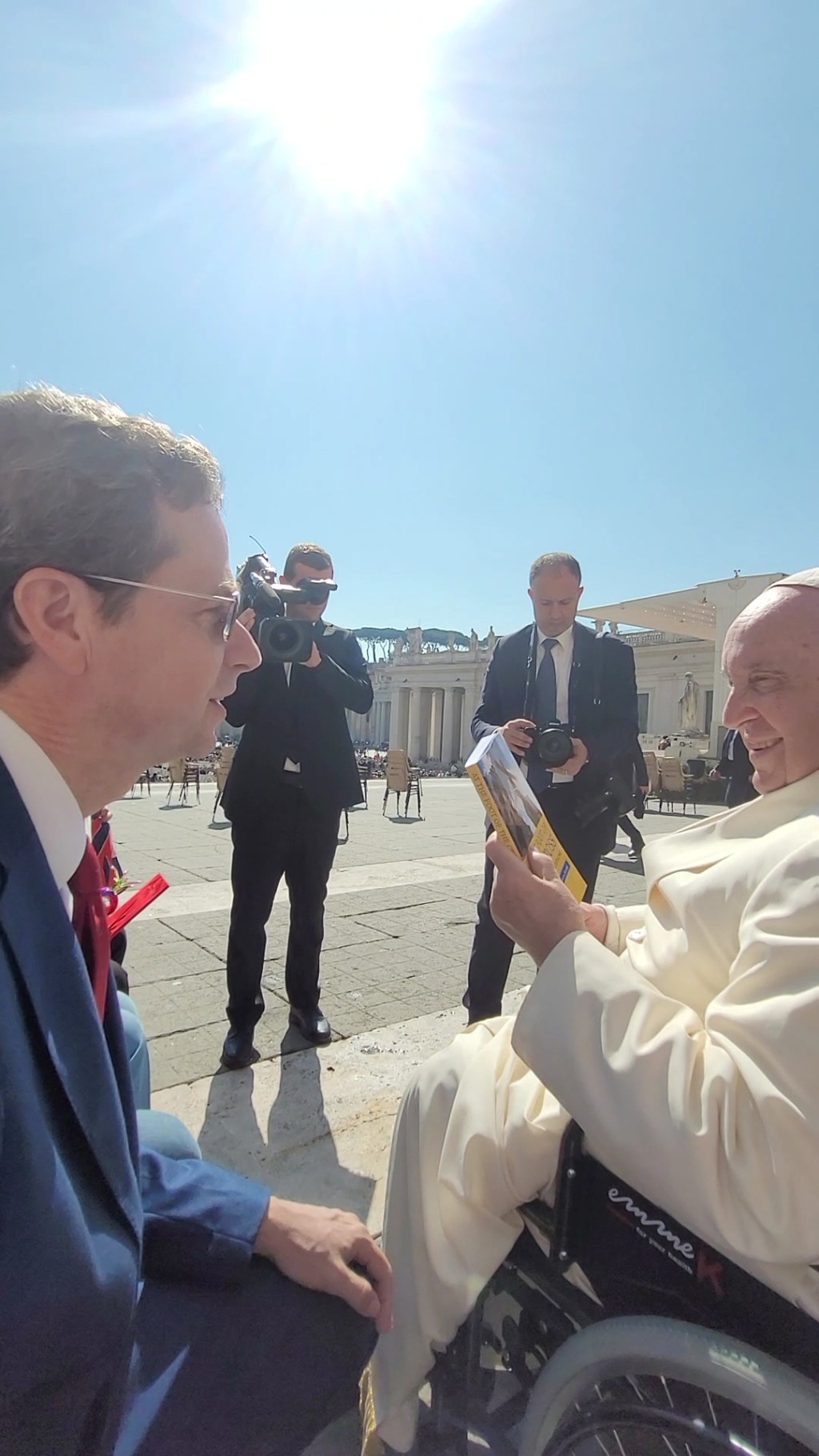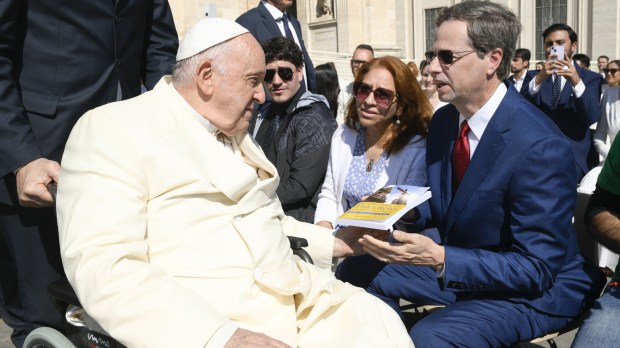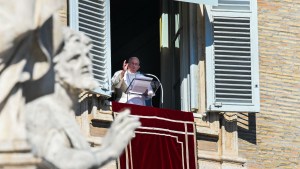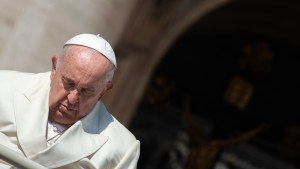The last encounter this Catholic journalist had with the man now known as Pope Francis was in 2008, at the International Eucharistic Congress in Quebec. Cardinal Jorge Mario Bergoglio, one of a number of cardinals and other luminaries from around the global Church to be invited to speak at the congress, was introduced at a press conference by Cardinal Marc Ouellet, archbishop of Quebec. I stood up to ask a question of the then-Archbishop of Buenos Aires, Argentina.
This past Wednesday, I finally made my first visit to Rome – long overdue for someone who grew up “Roman” Catholic. My wife and I, together with our niece and nephew, were blessed to have an opportunity to personally meet the Bishop of Rome.
It was a lovely spring day in the Eternal City. The weather in Italy had been decidedly on the cooler side, and the past few days had seen a good amount of rain. The priest who gave us special tickets for the Audience the afternoon before said he wasn’t sure if it would be held in the Square or in Paul VI Hall. It would depend on the weather, he said, and there was still a chance that Wednesday would see rain.
But an early morning cloud cover soon gave way to sunny skies, so the General Audience could be held in St. Peter’s Square.
Pope Francis, as everyone knows, has had some recent health challenges. On Good Friday, it was still too cold outside for him to preside at the Way of the Cross at the Roman Colosseum. At the Easter Vigil Mass in St. Peter’s Basilica and the Easter Sunday Mass and Urbi et Orbi Blessing, which we attended, he presided and led some prayers, but a cardinal took the burden off the Pope to actually “celebrate” the Mass.
Francis delivered homilies and discourses, however, and his voice seemed strong. “He speaks quickly,” I thought to myself. That’s certainly not the sign of someone who is ill. He also seemed happy and energized.
Our two-week visit included many of the highlights of the Church’s history – including prayers at the tombs of both St. Peter and St. Paul, the Catacombs of St. Callixtus, etc. On the Wednesday after Divine Mercy Sunday, our last full day in Rome, we made our way through the crowds to take our seats on the platform in front of St. Peter’s Basilica – near where Pope Francis normally celebrates Mass at an outdoor altar and where he now sat to deliver his weekly catechesis. Our position there came about as the result of a confluence of events. Our original plan to visit Italy, during the “Annus Pandemicus” of 2020, had to be postponed. It turned out that in the meantime, just about two months ago, Our Sunday Visitor published a book I’d been working on since 2018, the subject of which might have interested a small select few but now, because of a war in Eastern Europe, has taken on new significance.
Since we finally made plans to rebook our trip, I thought, I should try to get a copy of the book to the Holy Father. After all, the subject of the volume is a bishop he knew while he was Archbishop of Buenos Aires, and someone he has been in constant contact with since the Russian invasion of Ukraine in February 2022.
Before being elected Major Archbishop of Kyiv-Halych of the Ukrainian Greek Catholic Church, His Beatitude Sviatoslav Shevchuk led the small Ukrainian immigrant community in Argentina. He was 38 years old, and a first-time bishop. When I interviewed him for the book, At the Foot of the Cross: Lessons from Ukraine, he told me that Cardinal Bergoglio was something of a father figure to him, someone who taught him that bishops are to be servants, not princes, looking out for those on the margins, leading a Church that is a field hospital – all themes that would dominate the Bergoglian pontificate.
Now, His Beatitude Sviatoslav leads a Church that faces a major challenge with the Russian invasion, and the major archbishop (or patriarch, as many call him) has become a major voice in the spiritual response to that challenge.
Surely, I imagined, I could arrange a chance to talk to the Pope – even if the visit were only five minutes long. But everybody thinks his own story, his own work of art, his own whatever, is deserving of papal attention. I’m just one out of a billion Catholics, and the Pope is a finite man, with many demands on his time.
The Ukrainian witnesses
So even the “privileged few” who got special tickets to sit up on that platform at St. Peter’s are more than a few. We sat in about a dozen long rows of people, including many newlyweds and couples celebrating special anniversaries, wearing their wedding gowns and tuxedos. There was a large group of people in green shirts — apparently an apostolate where healthy people help people in wheelchairs on on pilgrimage. There were schools and bands and military groups, and people who wanted to present works of art they had created for the Pope. As we sat there under the Roman spring sun, the grand facade of St. Peter’s hovering over us, I thought of what I might say if I had the chance to speak while handing my autographed copy to the Pope. An assistant would push his wheelchair down each row, with just enough time for a handshake. So maybe I wouldn’t be able to say anything. I had intended to speak in English, but my wife, who is from Mexico, prepped me to be able to use the Pope’s native tongue. I debated with myself, feeling at times that I’d be lucky not to trip over my own words in English and that memorizing the Spanish version would just add an extra layer of stress.
But somehow I pulled it off. En Español! I had plenty of opportunity to mentally rehearse the words as the papal wheelchair made its way up and down the rows of plastic chairs and back and forth between us and groups of priests and bishops and organizations that wanted a group photo with the Pope on the front steps of the basilica.
I also had a chance to modify my “elevator speech,” to link it to what the Holy Father had just discussed in his catechesis. Like my Spanish, my Italian is good enough to get just a vague sense of what someone is saying, but I could tell that the pope was saying something about the martyrs of the Church. So in addition to telling him, “Holy Father, this is a book I’ve written about His Beatitude Sviatoslav Shevchuk,” a name he would certainly recognize, I added, “and the Ukrainian martyrs.”

Indeed, what the Pope said that day certainly applies to Ukraine. The Church’s martyrs “are more numerous in our time than in the first centuries,” he said, according to a transcript I found online later. “Today there are many martyrs in the Church, many of them, because for confessing the Christian faith they are banished from society or end up in prison.”
The word “martyr” derives from the Greek martyria, the Pope reminded us, which means “witness.”
“That is, a martyr is a witness, one who bears witness to the point of shedding their blood,” he said. But it need not be always that dramatic, he clarified: “A martyr can be one who witnesses every day.”
The Soviet Union and today
The martyrs of Ukraine of the 20th century, some of whom were beatified by Pope Francis’ predecessor, St. John Paul II, during his 2001 visit to Ukraine, witnessed primarily to Christian unity. When the Soviet Union took over all of Ukraine at the end of the Second World War, the Ukrainian Greek Catholic Church became illegal, and her members were given the opportunity to join the Russian Orthodox Church. But it lived on in an underground existence, becoming a “catacomb Church,” secretly holding Divine Liturgies in the privacy of homes. In the catacombs, the Church clung to her communion with the Bishop of Rome.
Many members of the Church – bishops, priests, deacons, religious and lay faithful – suffered in one way or another for this witness to Christian unity — some to the point of giving their lives.
One such witness, Metropolitan Josyf Slipyj, the head of the Ukrainian Greek Catholic Church, spent 18 years in the Soviet Gulag, until pressure from Pope St. John XXIII and the administration of President John F. Kennedy led to his release. He was allowed to live the rest of his life in exile – in Rome. There, he took part in the Second Vatican Council, served as spiritual leader of the Ukrainian Church in both the underground and in the free world, and built the Minor Basilica of Santa Sofia, the center of Catholic life for a growing Ukrainian community in Italy today.
His Beatitude Sviatoslav Shevchuk, who spent the first 18 years of his life in the catacomb Church and whose seminary professors had been imprisoned or tortured by Soviet authorities, has relied much on that experience in his leadership of the global Ukrainian Church since 2011. And he leads a Church in Ukraine now, which faces many of the same dangers that existed in Soviet times. In places occupied by Russian forces, the Church’s religious liberty is being severely restricted.
As the war continues in Ukraine, Pope Francis reminded us at the Wednesday General Audience that martyrdom is certainly not limited to the early days of the Church. He mentioned in his catechesis just one recent example – Missionary Sisters of Charity and lay people who gave their lives in Yemen, “a land that has for many years been afflicted by a terrible, forgotten war.” The Pope called them “martyrs of our time.”
“Let us pray,” the Holy Father concluded, “that we may never tire of bearing witness to the Gospel, even in times of tribulation. May all the martyr saints be seeds of peace and reconciliation among peoples, for a more humane and fraternal world, as we await the full manifestation of the Kingdom of Heaven, when God will be all in all.”



